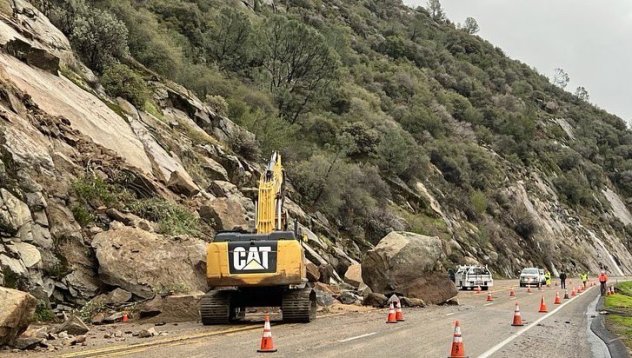
5 Incredible Videos That Captured The Ferocity Of The Atmospheric River


California’s most intense atmospheric river yet in the ongoing series of deadly severe storms exacerbated the dangerous conditions from the previous torrential rainfall, creating astounding — and terrifying — scenes at the beginning of the week.
Since New Year’s Eve, a parade of storms has slammed the Pacific Coast, the damaging rainfall and intense winds focused primarily on Northern and Central California. With little time to clean up and mitigate damages between storms, the impacts grew in intensity with each round of heavy rain, leading to devastating flooding, dangerous landslides and even a few large sinkholes.
More than a dozen storm-related fatalities have been recorded throughout the state as of Wednesday, and the economic toll is likely to place the storms as the year’s first billion-dollar weather event.
AccuWeather’s preliminary estimates of the total damage and economic cost from the series of storms lands between $31 billion and $34 billion following the deaths of 17 people, including at least one child, widespread power outages, major flooding, road closures, numerous landslides and mudslides and property damage.
It was during this severe weather that massive boulders came careening down mountainsides, celebrities provided weather commentary and one group of friends decided was perfect for golfing.
Here are just a few of the scenes that Californians captured during the intense storms at the start of the week:
In a video that has since gone viral, a round of golf at a seaside country club in Monterey County came to an end when a towering wave sent golfers scrambling for higher ground.
Peter Butler had been recording the rough surf as he and his friends watched from the 14th hole at Monterey Peninsula Country Club. One particularly massive wave caught their attention as it crashed ashore — and then the water showed no sign of stopping.
“Look at that, dude. It’s going to hit those cars,” one person mused as realization dawned on Butler.
“It’s going to hit us, dude,” he said, the waves charging forward.
A friend echoed his realization as they turned and bolted for higher ground.
“Go! Go!” Butler shouted, the video shaking as he ran. Their shouts were muffled by the sound of wind rushing past the microphone and the wave crashing in the background. When the camera steadied and turned face behind them, water was surging across the course and around their golf cart.
While the majority of the large-scale impacts from the storm focused on Northern and Central California, the southern end of the state didn’t escape unscathed. A massive sinkhole swallowed two vehicles driving along Iverson Road, south of the 118 Freeway, in the Los Angeles neighborhood of Chatsworth on Tuesday, Jan. 10.
Video taken at the scene showed a silver compact car badly damaged, lying at the bottom of the large open pit. The airbags still deployed, the bumper and headlights of the car were smashed in, though the hood remained intact. The ceiling retained numerous dents.
The second vehicle, a pickup truck, had landed on top of the compact car, according to KTLA News, trapping the smaller car’s two passengers — a woman and her teenage daughter — inside.
About 50 first responders from the Los Angeles Fire Department, Los Angeles County Fire and Ventura Fire worked for about an hour to free the mother and daughter and pull them out of the roughly 40-foot-deep sinkhole.
The passengers from the pickup truck were able to escape uninjured, and the mother and daughter were taken to the hospital with minor injuries.
As round after round of heavy rainfall hit the California coast, the risk of mudslides and rockslides across the state rapidly escalated.
One California Highway Police officer in Fresno County captured a dramatic video Monday of a rockslide careening down the mountain, crashing into the flooded road of State Route 168. No cars were in the path of the rockslide, and authorities cautioned travelers to avoid the area around the nearby Shaver Lake if possible.
Both intense rainfall and drought on their own can lead to landslides, and when heavy rain falls over a drought-stricken area, the odds of the mountainsides remaining stable aren’t much better.
“Drought across a region obviously can leave the ground exceptionally dry, especially as the drought conditions linger. When intense rainfall hits an area like that, it’s harder for the dry ground to absorb the rain,” AccuWeather Meteorologist Courtney Travis said. “Instead, it runs off and sweeps away any crumbly ground, especially in mountainous terrain.”
Data from the U.S. Drought Monitor shows the entirety of Fresno County was experiencing at least severe drought conditions during the final week of 2022, the widespread conditions dating back at least to September. As of Jan. 3, only 75% of the county remains under at least severe drought conditions.
Tuesday, the California Highway Police posted a photo of the fallen rocks near an excavator to provide a better perspective of the size of the fallen boulders.

Under the relentless rainfall, mudslides in upper Montecito, California, damaged a large section of road following evacuation orders for the area.
Dalton Schuster filmed a collapsed section of road on East Mountain Drive, near the home of the Duke and Duchess of Sussex, Prince Harry and Meghan Markle. Water rushed into the space that had fallen away, forming a small river.
The royal couple lives near the home of Portia de Rossi and Ellen DeGeneres, who filmed the intense flooding in Montecito on Jan. 9.
“This creek next to our house never flows,” DeGeneres said on camera, the creek behind her more akin to raging rapids than a stagnant stream.
All of Montecito as well as parts of Carpinteria, Summerland, and the city of Santa Barbara were called to leave under an immediate evacuation order on Monday, Jan. 9.
Strong thunderstorms delivered heavy rain and strong winds through the Bay Area during the early hours of Tuesday morning, moving out of the region by noon. However, they didn’t leave without throwing some hail into the mix.
Hailstones pelted the Bay Area and surrounding locations on Tuesday, Jan. 10, and while they might have been small, the little stones began piling up in some locations.
In San Ramon, a city in Contra Costa County, California, over 30 miles east of San Francisco, one Twitter user recorded as tiny hailstones piled up around their potted plants, covering a small patio.
One scene from Berkeley, a city located on the eastern shore of San Francisco Bay in Alameda County, showed a garden where the soil had been buried beneath the hail, though from a distance it easily appeared more like a light blanket of snow.
The current snowpack across the Sierra is 184 to 269% of normal for this point in the season, according to the agency.
Still, it’s important to remember that “these storms have not ended the drought,” the California Department of Water Resources said.
“Major reservoir storage remains below average, and conditions could turn dry again this winter, offsetting recent rain and snow,” state water officials said. “Statewide California reservoir storage is currently only 82% of average for this time of year. Lake Oroville storage is 88% of average for this date and the state’s largest reservoir, Shasta, is only 70% of average for the date.”
Produced in association with AccuWeather.
The Western Journal has not reviewed this story prior to publication. Therefore, it may not meet our normal editorial standards. It is provided to our readers as a service from The Western Journal.
Truth and Accuracy
We are committed to truth and accuracy in all of our journalism. Read our editorial standards.
Advertise with The Western Journal and reach millions of highly engaged readers, while supporting our work. Advertise Today.












